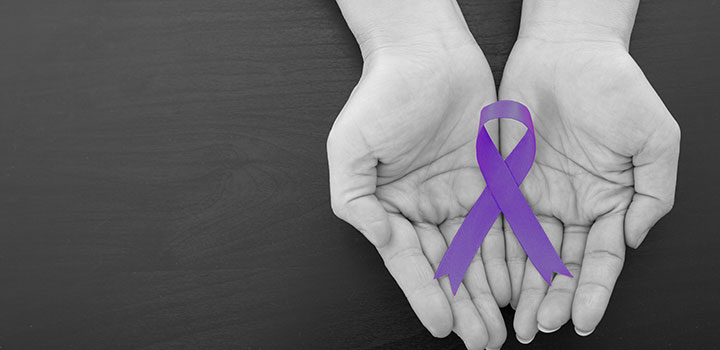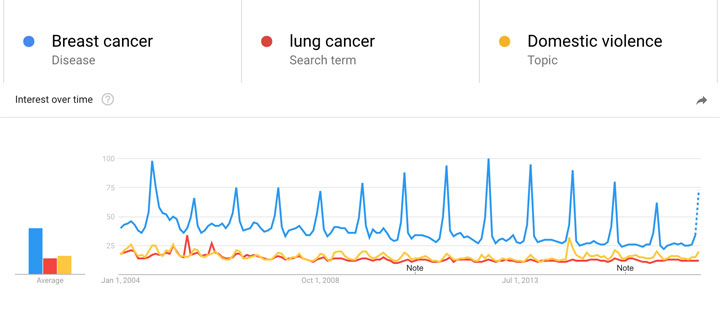It is time…to trade pink for purple!
I am tired of pink ribbons. Yes…the ribbon above is not a pink ribbon, it is purple. I want to trade.
Please, those who are breast cancer survivors, please do not judge me. Please hospitals that I represent, do not be think less of this opinion. I have not battled breast cancer, or any cancer for that matter. But, I have watched my wife’s mother die of breast cancer and experienced the same scare with my wife. I am done with pink ribbons…and it has nothing to do with lose of hope.
It is time to just admit it…I am over the pink ribbon campaigns.
I cannot believe as a digital media storyteller for healthcare organizations that I am about to write this phrase, I am aware and I no longer need to see pink again. I am tired of pink, I am so tired of pink that I am not sure if it has the same significance on my daughter as an innocent, fun color for a little girl.
I am tired of pink campaigns.
I am tired of seeing pink ribbons.
I am tired of being asked if I would wear a pink ribbon.
I am tired of walking into stores with pink adorned all across products.
I am tired of hospitals choosing this campaign as the only campaign to change their colors.
I am tired of Pink October.
We are aware…trust me. Our whole family!
If you look at the search volume via Google Trends since 2004, you will see that people have been searching for breast cancer in record numbers. They are searching because they are either aware or have been influenced to search to learn more. October is also domestic violence awareness month and breast cancer completely outpaces Google search volume.
Here is another tidbit of information; according to Cancer.org,
“Each year, more people die of lung cancer than of colon, breast, and prostate cancers combined.”
Look at the search volume for lung cancer in red…not even close. For such a deadly disease, is this search volume an indicator of awareness…or lack there-of.
In the healthcare digital and social media world, breast cancer is a large driver of traffic and potential income into a hospital. This is why we see hospitals change their websites to pink, their social media icons to pink, their campaigns center around breast cancer. This is why you see these same healthcare systems focus so much energy and effort behind breast cancer campaigns on Facebook.
Check out the United States demographics of people on Facebook. Notice something. More women than men. Pew Research states,
“Young adults continue to report using Facebook at high rates, but older adults are joining in increasing numbers. Some 62% of online adults ages 65 and older now use Facebook, a 14-point increase from the 48% who reported doing so in 2015. In addition, women continue to use Facebook at somewhat higher rates than men: 83% of female internet users and 75% of male internet users are Facebook adopters.”
With all this awareness, there are results. Since the 1970’s the lifetime risk of breast cancer has dropped from 1 in 10 to 1 in 8, which is a huge drop. This is in-part to awareness and advancement in technology.
So why not focus some energy on lung cancer? Lung cancer mainly occurs in older people. About 2 out of 3 people diagnosed with lung cancer are 65 or older, while less than 2% are younger than 45. The average age at the time of diagnosis is about 70.
Here is the kicker, healthcare systems know that raising awareness for breast cancer to women, specifically women in their mid 30’s and 40’s, they are influencing the healthcare decisions of the whole family. Hospitals gain critical access to a whole family when they treat a woman for breast cancer. They expose these woman to wonderful care showcasing their services in the hopes they bring the rest of their family for other services including pediatrics, orthopedics, and other services for family members including their parents, grandparents, husbands and children.
So why am I so invested in sharing this information. Because once again, here we sit…Sarah has another abnormal mammogram. I am not really worried this time around, for many reasons.
Last year she had a digital mammogram that showed something abnormal. This lead to more tests including an MRI that was prescribed and not paid for by the insurance company. This stress of the false positive, along with the history of her mother dying of triple negative metastatic breast cancer influenced us to make a decision for Sarah to have a breast reduction. Combined with the neck and back pain along with headaches, she was a perfect candidate; especially given we wanted to reduce her chances of getting breast cancer. For these reasons…I am not worried as much this time, we know the drill…and so it continues. We are aware. We are tried of being aware. Quite honestly, our awareness is no longer awareness, it is routine.
Each October we are reminded that her mother wore her pink, walked the walks, had lots of hope, but died at the age of 50 fighting this horrible disease. Each October, we walk into a store and see ribbons everywhere, walk into church and see the pews filled with pink hope. Hope was lost on September 17, 2007 when Mrs. Denise passed away.
We are aware. Trust me…
I am preparing for another fight with the insurance companies to pay for the MRI to see if those abnormalities are a real concern. I prepare to be a comfort to Sarah each time she leaves the radiology department; after each scan where the desk attendant asks her to wear a ribbon to raise awareness. Guess what, she is aware.
Are we not aware? Just go to Google and type breast cancer and see what pops up. Just look around during October, pink is not meant for little girls, it is used for ribbons to remind us, our family the nasty fight we keep fighting. We are so aware groups like Komen have tried to build empires on pink. Patent filings and trademark wars over the use of the color pink between Victoria Secret and Thomas Pink hit the headlines.
I am really starting to dislike the color and the awareness wars behind this disease. Maybe it is time for this large thrust of energy to wrap itself around a topic that needs more awareness, broad scale awareness for a bigger issue…domestic violence. Here is a statistic for you, 1 in 4 women will be victims of severe violence by an intimate partner in their lifetimes. Compare that to 1 in 8 women who have a lifetime risk of breast cancer. Hmm…those numbers do not lie.
There is a huge opportunity to not only bring voice to woman who are afraid, scared to leave their abusers; but also engage men to learn about healthy manhood. Two large groups of people, sound likes a novel investment opportunity to me.
Take a few minutes and read stories from local women who have experience abuse: SafeHarborSC.org/DefyTheLie/


